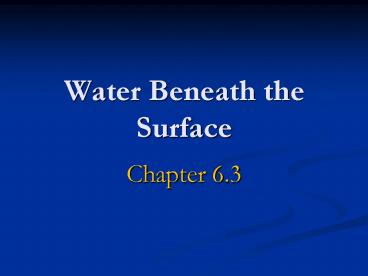Water Beneath the Surface - PowerPoint PPT Presentation
1 / 13
Title: Water Beneath the Surface
1
Water Beneath the Surface
- Chapter 6.3
2
Distribution of Water Underground
- Much of the water in soil seeps downward until it
reaches the zone of saturation - The zone of saturation is the area where water
fills all of the open spaces in sediment and rock - Groundwater is water below Earths surface within
the zone of saturation - The water table is the upper level of the
saturation zone of groundwater - The zone of aeration is the area above the water
table where the soil, sediment, and rock are not
saturated with water
3
Movement of Water Underground
- Groundwater moves by twisting and turning
through interconnected small openings - The groundwater moves more slowly when the pore
spaces are smaller - Porosity is the percentage of pore spaces in rock
- Determines how much groundwater can be stored
- Permeability is the ability to transmit water
through connected pore spaces - Aquifers are permeable rock layers or sediments
that transmit groundwater freely
4
Features Associated with Subsurface Water page
172
5
Water Beneath the Surface
- A spring forms whenever the water table
intersects the ground surface - Hot Springs have water that is 69ºC warmer than
the mean air temperature - Water is heated by cooling of igneous rock
- Geysers are hot springs that ejects water
- Water turns to steam and erupts
6
Geyser Eruption Cycle
7
Water Beneath the Surface
- A well is a hole bored into the zone of
saturation - An artesian well is any formation in which
groundwater rises on its own under pressure - Pumping can cause a lowering of the water table
- Pumping can form a cone of depression in the
water table
8
Cone of Depression
9
Environmental Problems
- Groundwater is being threatened by overuse and
contamination - In some regions, the amount of water available to
recharge an aquifer is less than the amount being
withdrawn - Common sources of groundwater pollution are
sewage from septic tanks, farm wastes, and
inadequate or broken sewers
10
Caverns
- A cavern is a naturally formed underground
chamber - Erosion forms most caverns at or below the water
table in the zone of saturation - Travertine (sedimentary rock) is a form of
limestone that is deposited by hot springs or as
a cave deposit - Also known as dripstone
11
Cavern Characteristics
- Formed from calcite deposited as dripping water
evaporates - Formed in the zone of aeration
- Common features include stalactites (hanging from
the ceiling) and stalagmites (growing upward from
the ground)
12
Karst Topography
- Formed by dissolving rock at, or near, Earths
surface - Common features include
- Sinkholes are surface depressions
- Sinkholes form when bedrock dissolves and caverns
collapse - Caves and caverns
- Area lacks good surface drainage
13
Sinkhole Formed































